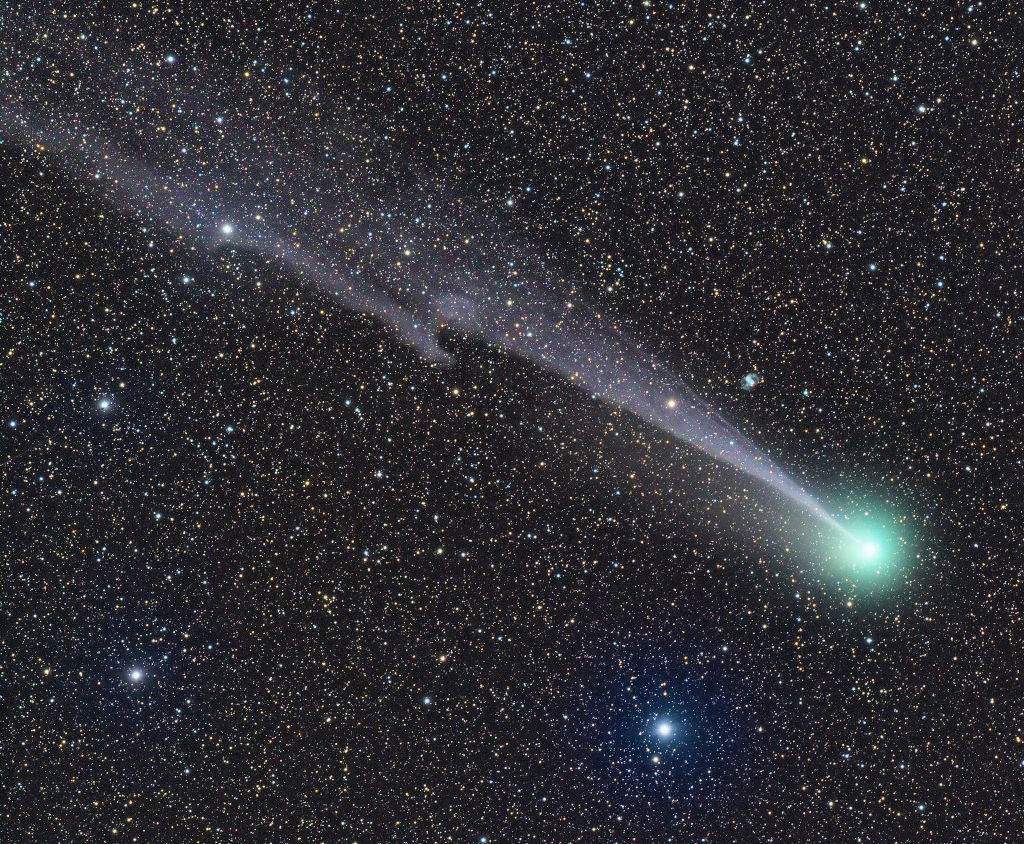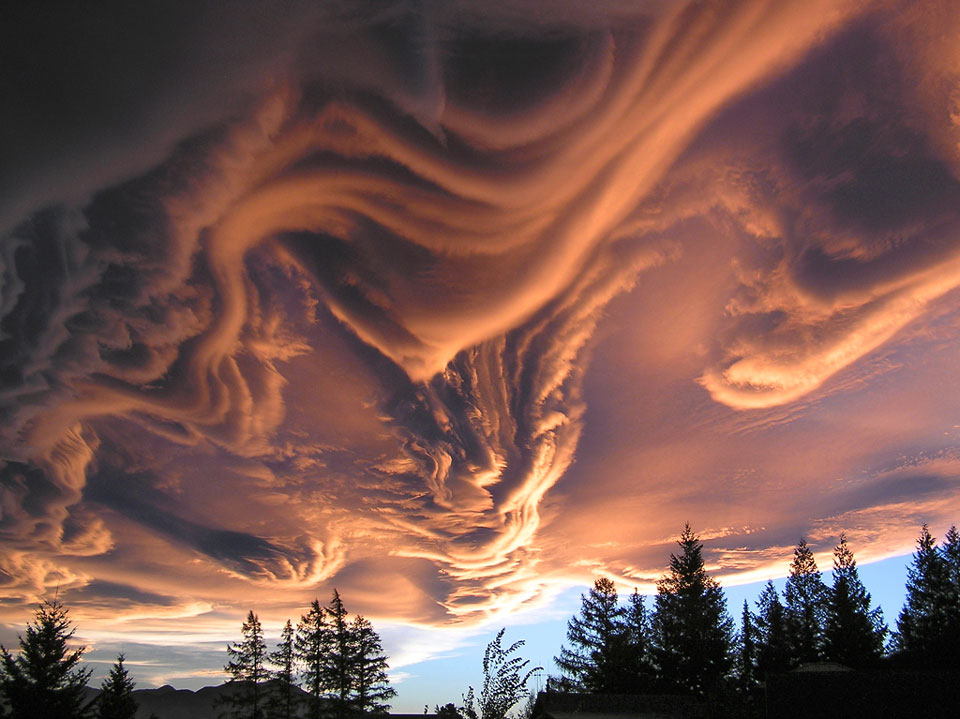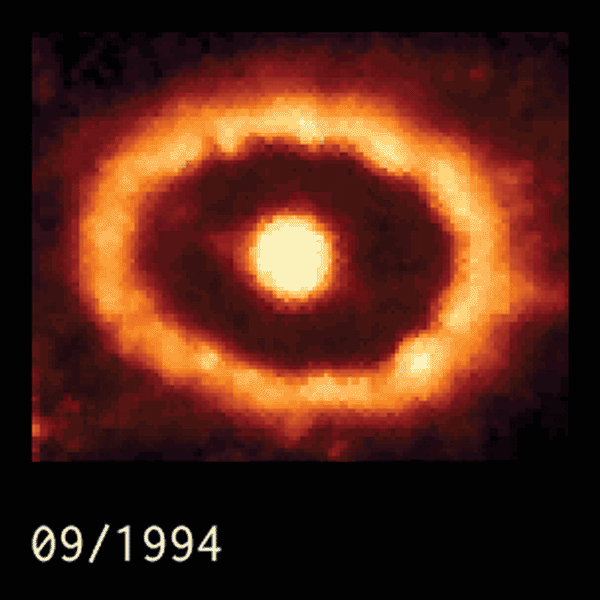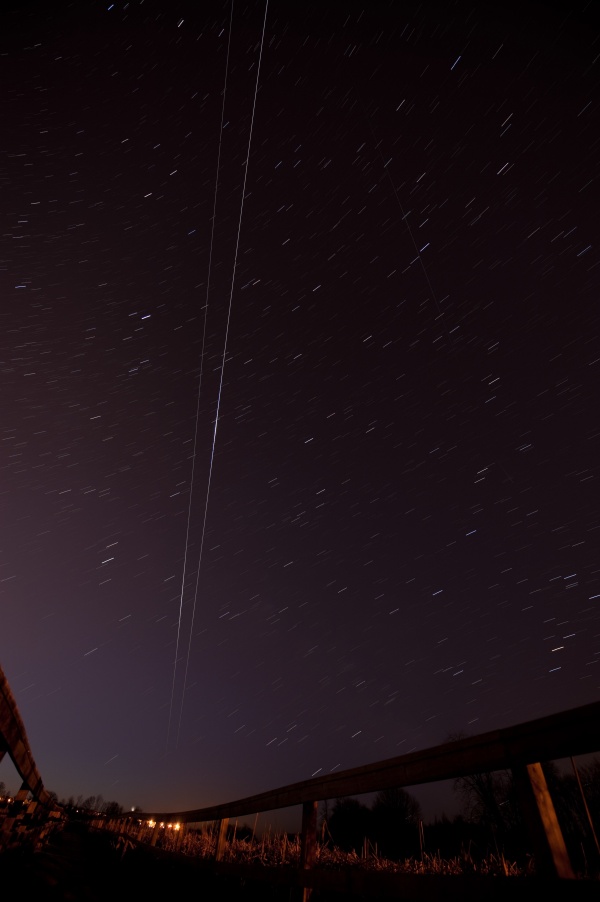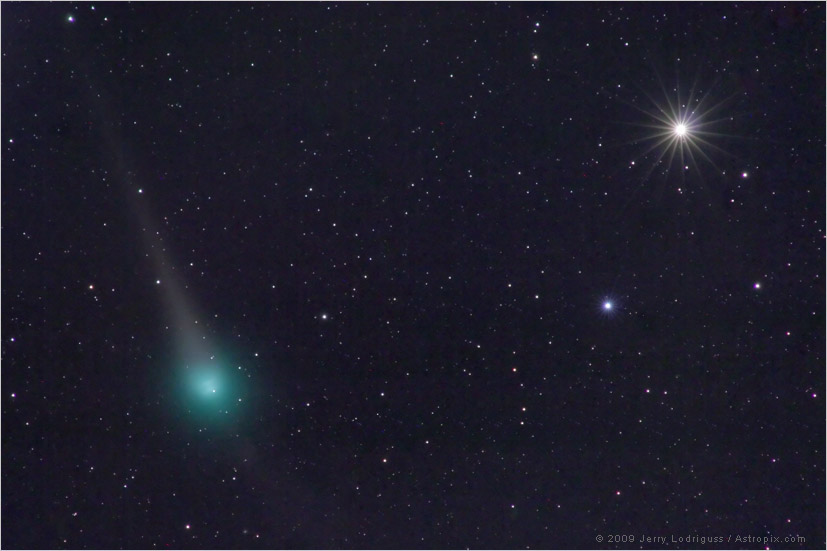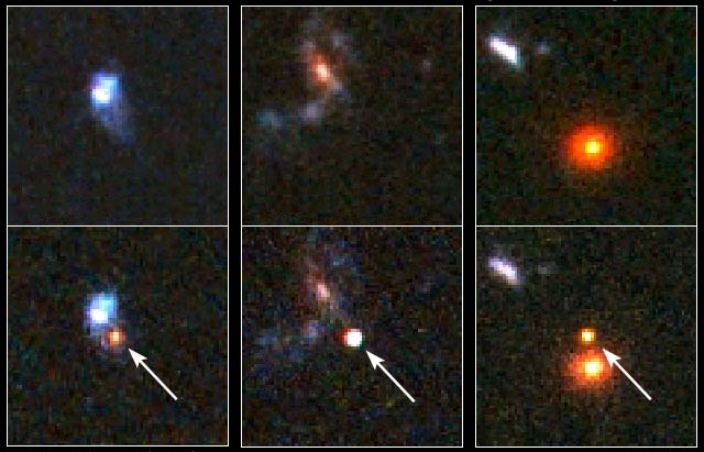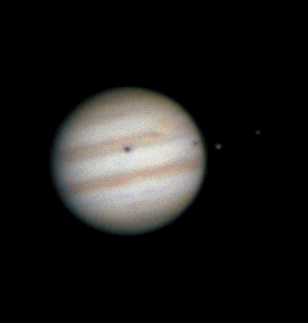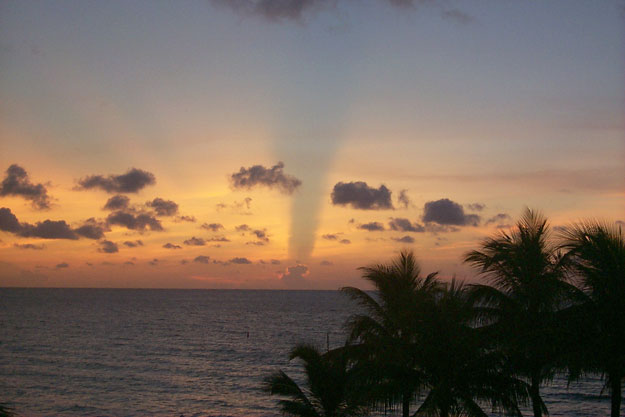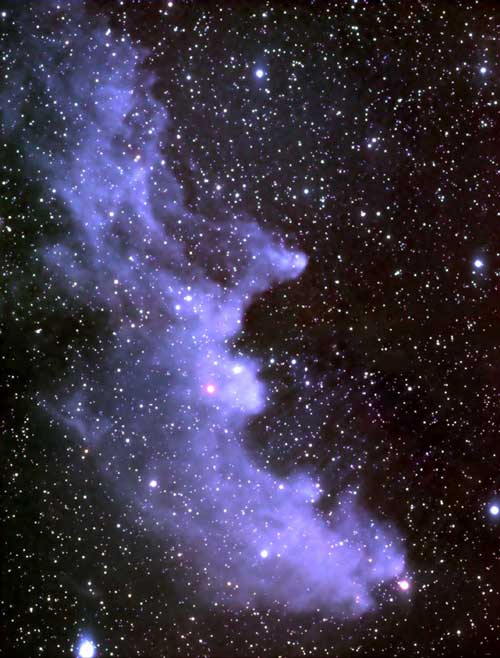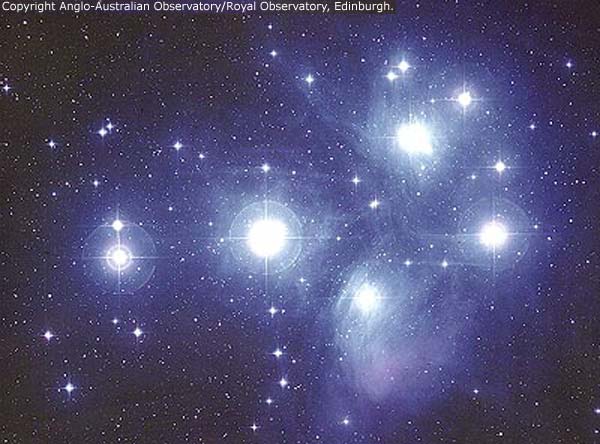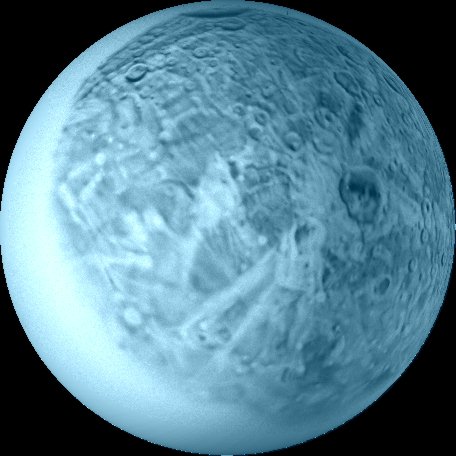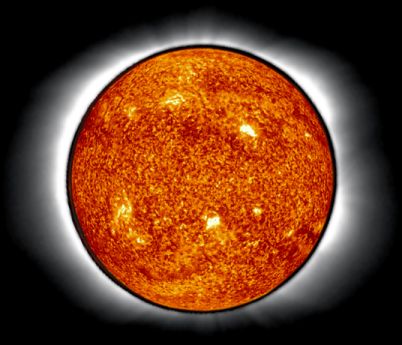| << Previous | Index | Next >> |
2015Buffeted by the solar wind, Comet Lovejoy's crooked ion tail stretches over 3 degrees across this telescopic field of view, recorded on February 20. The starry background includes awesome bluish star Phi Persei below, and pretty planetary nebula M76 just above Lovejoy's long tail. Also known as the Little Dumbbell Nebula, after its brighter cousin M27 the Dumbbell Nebula, M76 is only a Full Moon's width away from the comet's greenish coma. Still shining in northern hemisphere skies, this Comet Lovejoy (C/2014 Q2) is outbound from the inner solar system some 10 light-minutes or 190 million kilometers from Earth. But the Little Dumbbell actually lies 3 to 5 thousand light-years away. Now sweeping steadily north toward the constellation Cassiopeia Comet Lovejoy is fading more slowly than predicted and is still a good target for small telescopes.
2014 Venus now appears as planet Earth's brilliant morning star standing above the eastern horizon before dawn. For most, the silvery celestial beacon rose in a close pairing with an old crescent Moon on February 26. But seen from locations in western Africa before sunrise, the lunar crescent actually occulted or passed in front of Venus, also in a crescent phase. Farther to the east, the occultation occurred during daylight hours. In fact, this telescopic snapshot of the dueling crescents was captured just before the occultation began under an afternoon's crystal clear skies from Yunnan Province, China. The unforgettable scene was easily visible to the naked eye in broad daylight.
2013 What kind of clouds are these? Although their cause is presently unknown, such unusual atmospheric structures, as menacing as they might seem, do not appear to be harbingers of meteorological doom. Known informally as Undulatus asperatus clouds, they can be stunning in appearance, unusual in occurrence, are relatively unstudied, and have even been suggested as a new type of cloud. Whereas most low cloud decks are flat bottomed, asperatus clouds appear to have significant vertical structure underneath. Speculation therefore holds that asperatus clouds might be related to lenticular clouds that form near mountains, or mammatus clouds associated with thunderstorms, or perhaps a foehn wind -- a type of dry downward wind that flows off mountains. Such a wind called the Canterbury arch streams toward the east coast of New Zealand's South Island. The above image, taken above Hanmer Springs in Canterbury, New Zealand, in 2005, shows great detail partly because sunlight illuminates the undulating clouds from the side.
2012 Twenty five years ago, the brightest supernova of modern times was sighted. Over time, astronomers have watched and waited for the expanding debris from this tremendous stellar explosion to crash into previously expelled material. A clear result of such a collision is demonstrated in the above time lapse video of images recorded by the Hubble Space Telescope between 1994 and 2009. The movie depicts the collision of an outward moving blast wave with the pre-existing, light-year wide ring. The collision occurred at speeds near 60 million kilometers per hour and shock-heats the ring material causing it to glow. Astronomers continue to study the collision as it illuminates the interesting past of SN 1987A, and provides clues to the origin of the mysterious rings.
2011 What lies at the bottom of Hyperion's strange craters? Nobody's sure. To help find out, the robot Cassini spacecraft now orbiting Saturn swooped past the sponge-textured moon in 2005 and 2010 and took images of unprecedented detail. An image from the 2005 pass, shown above in false color, shows a remarkable world strewn with strange craters and a generally odd surface. The slight differences in color likely show differences in surface composition. At the bottom of most craters lies some type of unknown dark material. Inspection of the image shows bright features indicating that the dark material might be only tens of meters thick in some places. Hyperion is about 250 kilometers across, rotates chaotically, and has a density so low that it might house a vast system of caverns inside.
2010 On February 21st, the Space Shuttle Endeavour and the International Space Station (ISS) flew through the sky near dawn over Whitby, Ontario, Canada. Along with star trails, both were captured in this single time exposure. Glinting in sunlight 350 kilometers above the Earth, Endeavour slightly preceeded the ISS arcing over the horizon. But the brighter trail and the brighter flare belongs to the space station just visited by Endeavour. Near the completion of the STS-130 mission, hours later Endeavour made a night landing at Kennedy Space Center.
2009 Tracking through the constellation Leo on February 23rd, bright planet Saturn and Comet Lulin were both near opposition -- opposite the Sun in planet Earth's sky. They also passed within only 2 degrees of each other creating a dramatic celestial photo-op. Comet Lulin was near its closest approach to planet Earth at the time, at a distance of some 61 million kilometers, but was orbiting in the opposite direction. As a result it swept remarkably rapidly across the background of stars. This telephoto image captures both bright Saturn and greenish Lulin in the same field in a scene not too different from binocular views. Don't recognize ringed Saturn? The rings are presently tilted nearly edge-on to our view and the brighter planet is overexposed to record details of the fainter comet. At the upper right, Saturn is marked by multiple diffraction spikes created by the aperture blades in the telephoto lens.
2008 Bright blue stars are still forming in the dark pillars of the Eagle Nebula. Made famous by a picture from the Hubble Space Telescope in 1995, the Eagle Nebula shows the dramatic process of star formation. The above picture taken by a 0.8-meter telescope in the Canary Islands captures part of M16, the open cluster of stars that is being created. The high amount of detail in the above image results from it being taken only in specific colors of light emitted by hydrogen, oxygen, and sulfur. The bright blue stars of M16 have been continually forming over the past 5 million years, most recently in the famous central gas and dust columns that have been informally dubbed the Pillars of Creation and the Fairy. Light takes about 7,000 years to reach us from M16, which spans about 20 light years and can be seen with binoculars toward the constellation of the Serpent (Serpens).
2007 Do extrasolar planets have water? In an attempt to find out, the orbiting Spitzer Space Telescope made detailed observations of the atmospheres of two planets that orbit stars other than our Sun. Unfortunately, water vapor was not detected in either exoplanet. Spitzer watched star systems HD 209458b and HD 189733b closely in infrared light both before and after the parent stars eclipsed their known planets. By comparing eclipsed and uneclipsed spectra very closely, astronomers could deduce bright light-emitting atmospheric gasses that were being blocked during eclipse. Were water vapor one of these atmospheric gases, a new indication that life might exist outside of our Solar System would have been found. The planets being analyzed are known as hot Jupiters -- they have sizes close to Jupiter but orbits closer to the distance of Mercury. The above illustration shows an artist's depiction of one of these dry worlds. Although no water vapor was detected this time, the techniques of measuring exoplanet atmospheres are quite promising, and the search for distant water and other biomarkers is just beginning.
2006 What is it? Something is happening in a small portion of the sky toward the constellation of Aries. Telescopes around the globe are tracking an unusual transient there as it changes day by day. No one is sure what it will do next. The entire space mystery began on February 18 when the Earth-orbiting robot Swift satellite noticed an unusual transient began to glow dimly in gamma rays. Dubbed GRB 060218, the object is a type of gamma ray burst (GRB) but the way its brightness changes is very unusual. Since detection, GRB 060218 has been found to emit light across the electromagnetic spectrum, including radio waves and visible light. Pictured above, the Sloan Digital Sky Survey (SDSS) image of the field of GRB 060218 well prior to its Swift trigger is shown on the left, while the same field, taken by the orbiting Swift satellites' ultraviolet telescope after the Swift trigger, is shown on the right. The oddball GRB is visible in the center of the right image. Subsequent observations found a redshift for the transient of z=0.033, showing it to be only about 440 million light years away, relatively nearby compared to typical GRBs. Whether GRB 060218 represents a new type of gamma ray burst, a new type of supernova, or an unusual link between the GRBs and supernovas has become an instant topic of research.
2005 It is still not known why the Sun's light is missing some colors. Shown above are all the visible colors of the Sun, produced by passing the Sun's light through a prism-like device. The above spectrum was created at the McMath-Pierce Solar Observatory and shows, first off, that although our yellow-appearing Sun emits light of nearly every color, it does indeed appear brightest in yellow-green light. The dark patches in the above spectrum arise from gas at or above the Sun's surface absorbing sunlight emitted below. Since different types of gas absorb different colors of light, it is possible to determine what gasses compose the Sun. Helium, for example, was first discovered in 1870 on a solar spectrum and only later found here on Earth. Today, the majority of spectral absorption lines have been identified - but not all.
2004 Only a few short years ago, when the APOD editors were in graduate school, the pervasive, cosmic Dark Energy was not even seriously discussed. Of course, it now appears that this strange energy dominates the cosmos (as well as lectures on cosmology) and provides a repulsive force accelerating the large scale expansion of the Universe. In fact, recent brightness measurements of distant and therefore ancient, stellar explosions or supernovae indicate that the universal expansion began to speed up in earnest four to six billion years ago, when the Dark Energy's repulsive force began to overcome the attractive force of gravity over cosmic distances. The Hubble Space telescope images above show a sample of the distant supernova explosions, billions of light-years away, in before (top) and after (bottom) pictures of their faint host galaxies. Hubble measured supernovae also hint that the Dark Energy's repulsive force is constant over cosmic time and so could be consistent with Einstein's original theory of gravitation. If the force actually changes with time, the Universe could still end in a Big Crunch or a Big Rip ... but not for at least an estimated 30 billion years.
2003 It's no wonder Jupiter is a favorite target for even modest earthbound telescopes. The most massive planet in the solar system with four of the largest moons also boasts the famous Great Red Spot, a giant hurricane-like storm system over three hundred years old. Recorded on December 15, 2002 between 7:19 and 8:40 UT, over a thousand digital images were processed and stacked to create this spectacular 21 frame animation of the Jovian system. South is up and as the Great Red Spot tracks across the face of Jupiter, innermost Galilean moon Io enters the scene at the far right. Io occults (passes in front of) the edge of the more sedately orbiting Ganymede with Io's shadow moving quickly across the gas giant's cloud tops, just below the Red Spot. While the moon Callisto is outside the field of view, its large, dark shadow is also visible crossing the Jovian disk at the upper left. Viewed from Earth, the orbits of the Galilean moons presently lie nearly edge-on, offering many chances to observe similar dances of Jupiter's moons.
2002 What could cause a ray of dark? Such a ray was caught in spectacular fashion above the Florida Everglades two years ago. The cause is something surprisingly familiar: a shadow. The gold-tinged cloud near the horizon blocks sunlight from reflecting off air behind the cloud, making that column of air appear unusually dark. Cloud shadows can be thought of the inverse of the more commonly highlighted crepuscular rays, where sunlight pours though cloud holes. Another seemingly opposite phenomenon, a sun pillar, involves small ice crystals floating high in the atmosphere.
2001 Double, double toil and trouble; Fire burn, and cauldron bubble -- maybe Macbeth should have consulted the Witch Head Nebula. This suggestively shaped reflection nebula is associated with the bright star Rigel in the constellation Orion. More formally known as IC 2118, the Witch Head Nebula glows primarily by light reflected from Rigel, located just outside the top right corner of the above image. Fine dust in the nebula reflects the light. The blue color is caused not only by Rigel's blue color but because the dust grains reflect blue light more efficiently than red. The same physical process causes Earth's daytime sky to appear blue, although the scatterers in Earth's atmosphere are molecules of nitrogen and oxygen. The nebula lies about 1000 light-years away.
2000 It is the most famous star cluster on the sky. The Pleiades can be seen without binoculars from even the depths of a light-polluted city. Also known as the Seven Sisters and M45, the Pleiades is one of the brightest and closest open clusters. The Pleiades contains over 3000 stars, is about 400 light years away, and only 13 light years across. Quite evident in the above photograph are the blue reflection nebulae that surround the bright cluster stars. Low mass, faint, brown dwarfs have recently been found in the Pleiades.
1999 What's in a name? Since 1919, the International Astronomical Union has been charged with the task of establishing "conventional" nomenclature for planets, satellites, and surface features. For the remote Uranian system of moons, namesakes from Shakespearean works have been chosen. Thus Oberon, king of the mid-summer night fairies, is also Uranus' most distant and second largest moon. Hamlet is the tragically dark, large and princely crater on its surface (right of center). The above image represents known surface features of Oberon and was constructed by the U.S. Geological Survey (USGS) based on data from NASA's robot explorer Voyager 2. In 1986, Voyager 2 flew through the Uranian system - so far it has been the only spacecraft to do so.
1998 Yesterday, the Moon's shadow reached out and touched the Earth, treating a large portion of the Western Hemisphere to an Eclipse of the Sun. This composite image combines pictures of the Sun made from both Earth and space. The central direct image of the solar surface was recorded yesterday by the Extreme Ultraviolet Imaging Telescope on board the space based SOHO observatory. It is surrounded by a telescopic picture of the Sun as seen from the island of Aruba during the total eclipse. The surrounding view of the eclipsed Sun reveals the gleaming solar corona, visible to ground based observers during totality. Such combined images can help connect explosive events and features on the Sun's surface with the corona and solar wind.
1997 What's that fuzzy star? It's not a star, it's Comet Hale-Bopp. Not only has Comet Hale-Bopp become easy to see in the morning sky, it has become hard not to see it. It's that bright. Any morning just before sunrise, look towards the east. Comet Hale-Bopp is one of the brightest objects up. Its dominating presence is shown dramatically by this photo taken just west of Williston, North Carolina, USA. Here Comet Hale-Bopp shines above the telephone poles lining Highway 70. Too tired to get up in the morning to see the comet? Don't worry, in less than a month it will also be visible in the evening sky, just before sunset. And it will have a longer tail. From the Space Shuttle, Dr. Steven Hawley says, "Hale-Bopp looks great."
1996 An X-ray star winks out behind the Moon in these before and after views of a lunar occultation of the galactic X-ray source designated GX5-1. The false color images were made using data from the ROSAT orbiting observatory and show high energy X-rays in yellow (mostly from GX5-1), and lower energy X-rays in red (the Moon reflecting X-rays from the Sun). GX5-1 is a binary system consisting of a neutron star and a companion star in mutual orbit about the system's center of mass. The gas in the companion star's outer envelope falls toward the neutron star and accumulates in a disk around it. This disk material swirls deeper in to the neutron star's gravitational well, and is finally dumped onto its surface - in the process creating tremendous temperatures and generating the high energy X-rays.
| << Previous | Index | Next >> |
